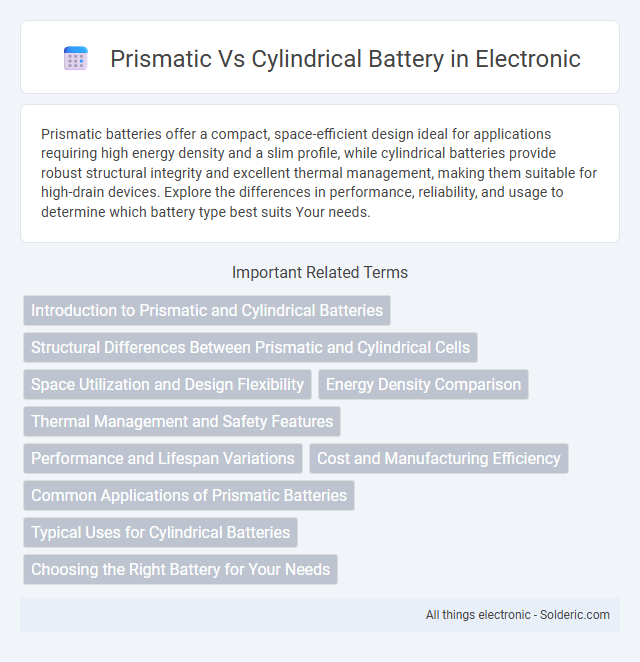Prismatic batteries offer a compact, space-efficient design ideal for applications requiring high energy density and a slim profile, while cylindrical batteries provide robust structural integrity and excellent thermal management, making them suitable for high-drain devices. Explore the differences in performance, reliability, and usage to determine which battery type best suits Your needs.
Comparison Table
| Feature | Prismatic Battery | Cylindrical Battery |
|---|---|---|
| Shape | Rectangular or square | Round |
| Energy Density | High volumetric density | High gravimetric density |
| Space Utilization | Efficient in devices with limited space | Less efficient due to curved shape |
| Thermal Management | More challenging, requires cooling systems | Better heat dissipation |
| Manufacturing Cost | Higher due to complex design | Lower, mass-produced standard sizes |
| Durability | Moderate, sensitive to swelling | High, robust structure |
| Applications | Electric vehicles, smartphones, tablets | Laptop batteries, power tools, electric bikes |
Introduction to Prismatic and Cylindrical Batteries
Prismatic and cylindrical batteries differ primarily in shape and internal structure, impacting their energy density and application. Prismatic batteries feature a rectangular shape with layered components, allowing for efficient space utilization in devices like smartphones and electric vehicles. Cylindrical batteries have a round shape with spiral-wound cells, commonly used in laptops and power tools due to their robustness and better thermal management.
Structural Differences Between Prismatic and Cylindrical Cells
Prismatic cells feature a rectangular, flat shape that maximizes space efficiency and allows better stacking in battery packs, while cylindrical cells have a round, tube-like structure designed for optimal mechanical stability and thermal management. The structural design of prismatic batteries enables higher energy density per unit volume, whereas cylindrical batteries benefit from standardized sizes and robustness against physical impacts. Your choice between these battery types depends on the desired balance between compactness and durability in applications like electric vehicles or portable electronics.
Space Utilization and Design Flexibility
Prismatic batteries offer superior space utilization due to their rectangular shape, allowing for more efficient packing and optimized use of available volume in devices. Cylindrical batteries provide greater design flexibility by fitting into curved or irregular spaces and enabling modular arrangements in battery packs. Choosing between prismatic and cylindrical cells depends on the balance between maximizing internal device space and accommodating diverse form factors.
Energy Density Comparison
Prismatic batteries typically offer higher volumetric energy density compared to cylindrical batteries due to their shape, allowing better space utilization in compact devices. Cylindrical batteries possess excellent thermal management and mechanical stability, which can enhance energy density in high-drain applications. Your choice depends on balancing space constraints, energy capacity, and thermal efficiency requirements.
Thermal Management and Safety Features
Prismatic batteries offer better thermal management due to their flat, rectangular shape, which allows for efficient heat dissipation through larger surface areas and uniform cooling systems. Cylindrical batteries often require individual cell cooling because their shape traps heat more easily, increasing the risk of thermal runaway and necessitating enhanced safety features like venting mechanisms. Advanced safety systems in prismatic batteries include integrated temperature sensors and pressure relief valves, while cylindrical cells rely on robust casings and separator materials to prevent short circuits and overheating.
Performance and Lifespan Variations
Prismatic batteries offer a higher energy density and more stable performance under varying temperatures compared to cylindrical batteries, which excel in heat dissipation due to their shape. Cylindrical cells typically have a longer lifespan because their design reduces mechanical stress and enhances structural integrity, leading to better cycle durability. Variations in performance also arise from manufacturing processes, with prismatic cells showing more capacity degradation under high load conditions relative to cylindrical types.
Cost and Manufacturing Efficiency
Prismatic batteries typically offer lower manufacturing costs due to their simplified stack design and better space utilization, which reduces material waste and assembly time. Cylindrical batteries require more complex winding and additional casing, increasing production expenses and complexity. The cost-efficiency of prismatic cells makes them favorable for large-scale electric vehicle applications where volume and manufacturing speed are critical factors.
Common Applications of Prismatic Batteries
Prismatic batteries are commonly used in electric vehicles, portable electronics, and renewable energy storage systems due to their compact design and high energy density. Their flat, rectangular shape allows better space utilization in smartphones, tablets, and laptops, optimizing device design and performance. In automotive applications, prismatic cells provide efficient power delivery and thermal management, making them ideal for hybrid and full electric vehicle battery packs.
Typical Uses for Cylindrical Batteries
Cylindrical batteries are commonly used in portable electronics, power tools, and electric vehicles due to their standardized sizes and reliable energy density. They are widely found in laptops, flashlights, and electric bikes, benefiting from high discharge rates and efficient thermal management. The robust structure of cylindrical batteries also makes them ideal for applications requiring durability and consistent performance under varying conditions.
Choosing the Right Battery for Your Needs
Selecting between prismatic and cylindrical batteries depends on your application requirements, space constraints, and energy density needs. Prismatic batteries offer a compact, space-efficient design with higher energy density, ideal for devices where maximizing capacity within a limited volume is critical. Cylindrical batteries provide robust structural integrity and better thermal management, making them suitable for high-drain applications and ease of manufacturing in power tools and electric vehicles.
Prismatic vs Cylindrical battery Infographic

 solderic.com
solderic.com